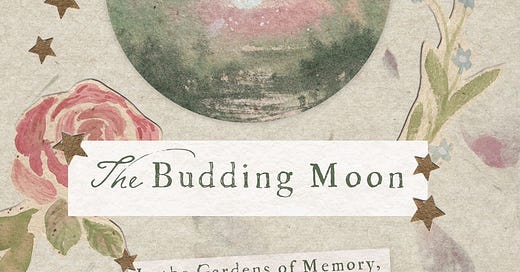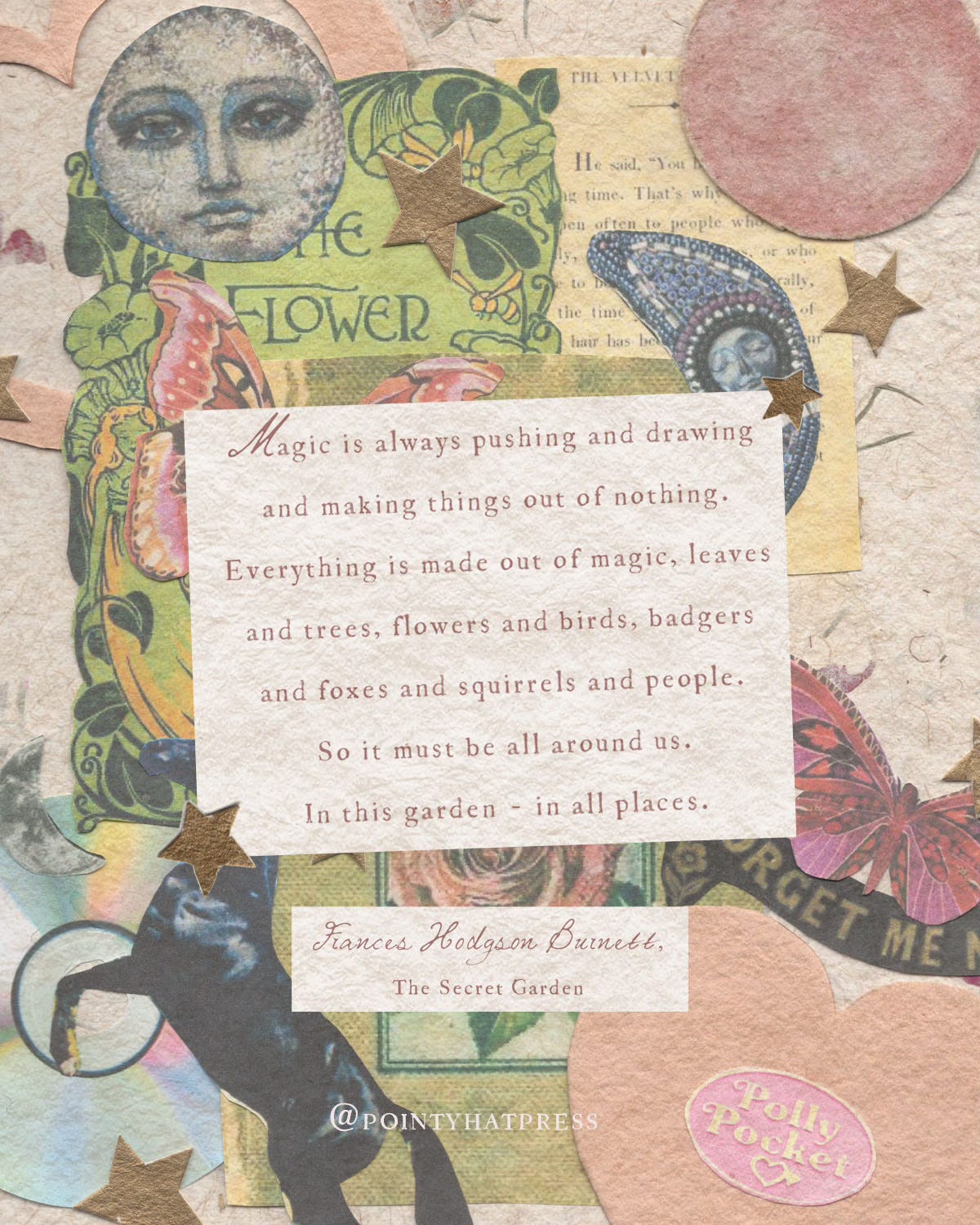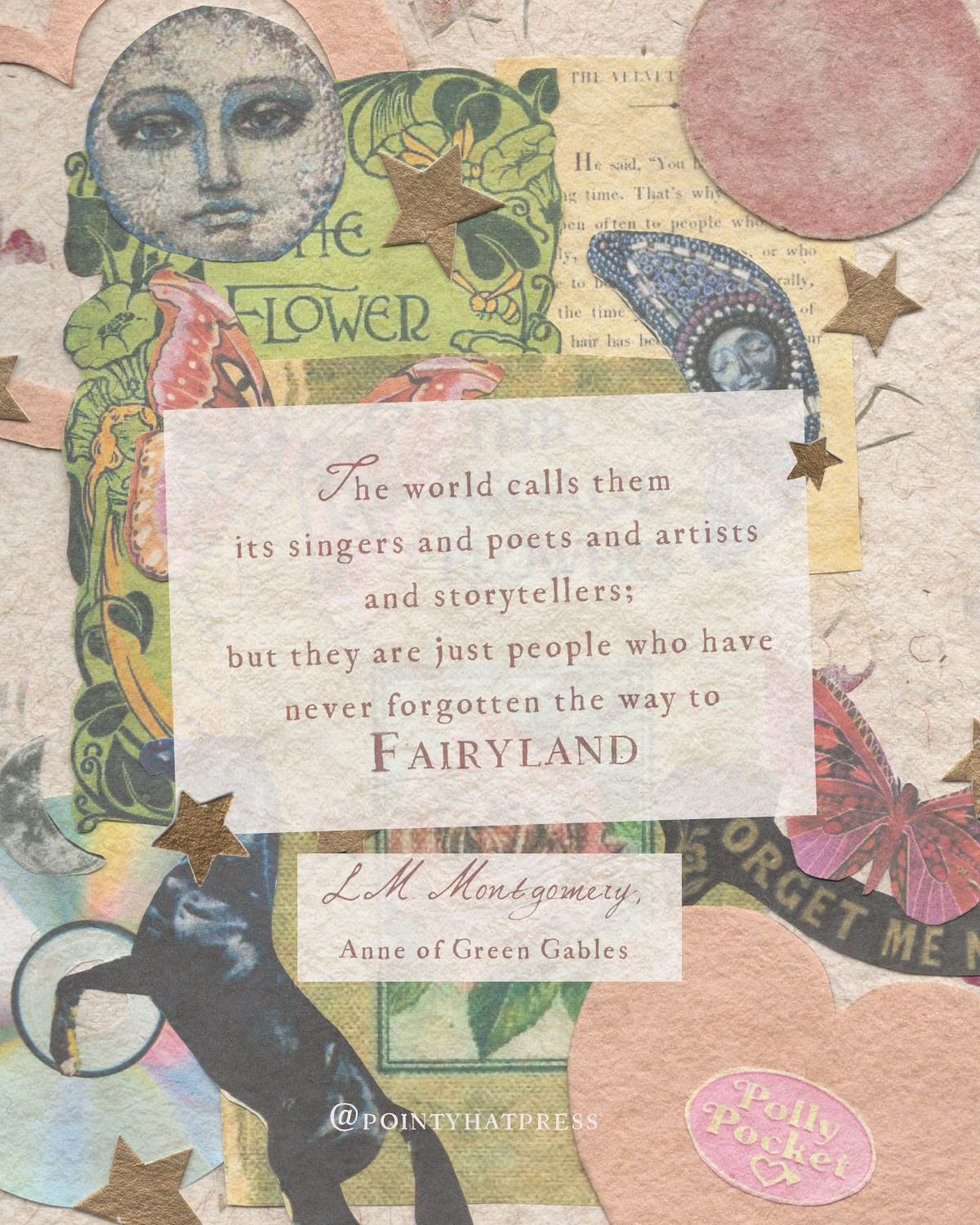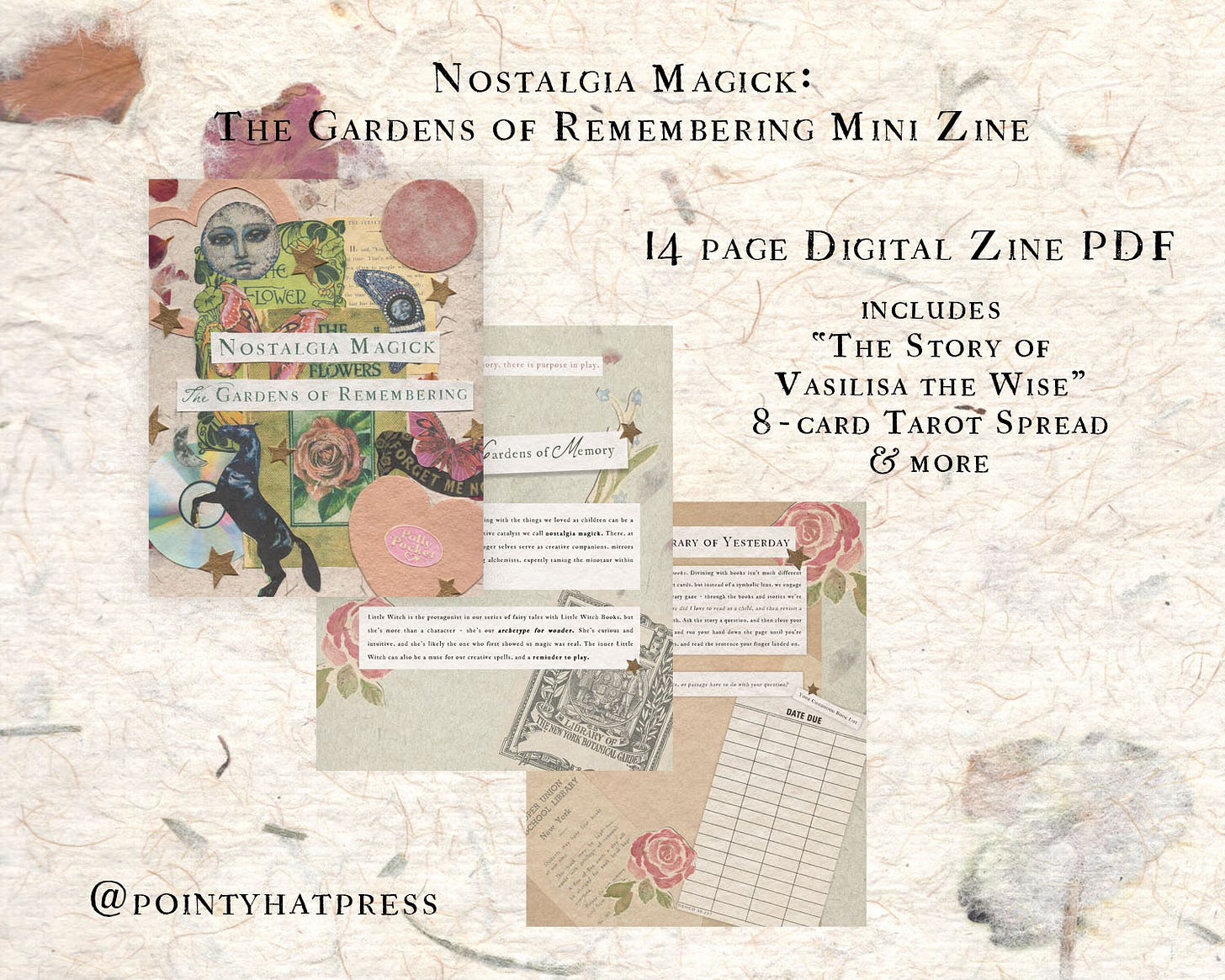Nostalgia Magick & The Gardens of Memory
Building an altar for our inner Little Witches beneath February's Full Moon.
“You might have heard witches describe their magickal journeys as lessons in remembering. Which is a beautiful way to say that our roots endure, perhaps stretching wider and reaching further back in time than we ever imagined possible. Every so often, those ancient roots spiral back to the surface in the form of memories, and a longing for something that was nearly (but luckily not) forgotten.
We can work with that yearning, our remembering, to support the foundation of our craft. Think of it as a form of nostalgia magick – a way to reconnect with the inner child or previous version of yourself. This person is curious, receptive, and sees magick in everyone and everything around them, which is why I call them the inner Little Witch. We might also know her as the Maiden or crescent moon, the Page in tarot, or the optimistic, eternal student of life. She goes by many names, but her mission remains the same – remember.”
- Nostalgia Magick: Spells for Little Witches of All Ages, Pointy Hat Press for Witchology Magazine, The Shadow Issue
Nicknamed the Snow Moon, Milk Moon, Hungry Moon, Storm Moon, Eagle Moon, and our favorite, the Budding Moon, February's moon rises over the Gardens of Memory.
Held by the moon, the earth softens, and our inner Little Witch tends to the plants. She presses her palms into the dirt and forages for nostalgia and purpose through play. She digs up our well-loved Polly Pockets, our favorite books from yesteryear, and spreads out our memories like trinkets on an altar.
Arranging the fossils of our youth into a foundation for our creative and magickal practices is a spell for the soul. Because while we've hopefully matured since our tender teenage era, the things we loved during our formative years have a way of showing up again and again. And each time, the grounds of inspiration acquire a new layer of meaning. Not surprisingly, for as long as mine and Caitlyn’s childhood memories serve, books and enchanted artwork have been lighting up our skies like shooting stars.
“I think it is all a matter of love; the more you love a memory the stronger and stranger it becomes” ― Vladimir Nabokov
From a magickal perspective, reuniting with the things we loved as children can be a potent potion, a doorway into the creative catalyst we call nostalgia magick. There, at the altar of our remembering, our younger selves serve as creative companions, mirrors through which to scry, and unassuming alchemists, expertly taming the minotaur within the soul's labyrinth.
In the Gardens of Memory, there is purpose in play.
Little Witch is the protagonist in our series of fairy tales with Little Witch Books, but she’s more than a character – she’s our archetype for wonder. Our inner Little Witch is curious and intuitive, and she’s likely the one who first showed us magic was real. She can also be a muse for our creative spells, and a reminder to play.
“Aspects of Witchcraft rituals may sometimes seem silly to very serious-minded people, who fail to realize that ritual is aimed at Younger Self. The sense of humor, of play, is often the key to opening the deepest states of consciousness. Part of the “price of freedom,” then, is the willingness to play, to let go of our adult dignity, to look foolish, to laugh at nothing. A child makes believe that she is a queen; her chair becomes a throne. A Witch makes believe that her wand has magic power, and it becomes a channel for energy.” - Starhawk
Through the lens of cartomancy, the archetypal Little Witch is the Page in Tarot. As the herald of new tidings, new ventures, dreams, and possibilities, the Page is a quest-driven student. They’re energetic and curious, and much like the inner Little Witch, the Page is a messenger and storyteller.
In fairy tales and folk stories, the archetypal Little Witch is our unlikely heroine - the maiden who, against all odds, completes the impossible tasks and gets her happy ending (most of the time). Her heart is pure and her intuition intact, so she’s often aided by an otherworldly helper or two. Sometimes, the helper shows the girl how to spin straw into gold (think Rumpelstiltskin), or they take the form of a fairy godmother (Briar Rose). In the story of Vasilisa the Wise, our heroine is guided by a magical doll enchanted with prayers from the dead.
Fairy Tales & the Inner Little Witch: The Story of Vasilisa the Wise
Once upon a time when witches ruled the wildwood, a woman became a mother. She looked at her daughter’s perfect face and blessed her with a name — Vasilisa the Beautiful.
Vasilisa’s parents were very much in love, but they were not destined to grow old together. Death visited Vasilisa’s home the winter before her 8th birthday, and when the reaper left in spring, Vasilisa’s mother went with him.
When Vasilisa’s mother died, all the warmth in the old house escaped with her. Vasilisa’s father struggled to light the hearth, and a chill clung to the walls even when the flame took. At night, Vasilisa shivered beneath heavy quilts and begged the shadows recall every detail about her mother.
The girl clutched a tiny doll to her chest as she and the darkness danced. The doll was mostly twig, part cornhusk, with a bit of leftover fabric and burlap sewn together, but to Vasalisa, this doll was crafted from the very essence of her mother. About a month before her mother got sick, Vasalisa made the poppet beneath the final rays of harvest season. The doll appeared no different than any other doll, but, once upon a time, looks were deciding. This doll was enchanted. This doll was alive.
If Vasilisa’s mother anticipated her earthly departure, she said nothing. Instead, she showed her daughter how to feed the doll and speak its language. She explained that the poppet would protect her in exchange for a bit of food, drink, and a few words about her grief. She made Vasilisa promise to never mention the doll, not even to her father.
One night, while Vasilisa cried beneath her heavy quilts, the doll drank her tears and nibbled on her grief. She spoke to the poppet about heartache and loss, and soon, Vasilisa stopped shivering. For the first time since her mother left, Vasilisa fell asleep and dreamt of fire.
The following morning, Vasilia’s father announced his intent to remarry. That same afternoon, he invited his would-be-bride and her two daughters into their home. He didn’t seem to notice that his step-daughters were cruel, or that his new wife reeked of jealousy. He didn’t see she resented Vasilisa’s beauty, her innocence, and the warmth that followed the girl from one room to the next. He didn’t realize that his new wife hated the cold walls and the flickering hearth, or that she despised sharing a home with a motherless child. And so, when he left for his annual trip to the neighboring kingdom, he never expected the women to douse the fireplaces and snuff out all the candles.
“Don’t bother coming back until you find a flame to rid the ice from these walls,” said Vasalisa’s stepmother as she pushed the girl out the door.
Vasilisa trembled. Her hands shook as she rubbed the doll in her pocket and fed it a bit of crust she’d saved from breakfast. When she invited it to drink from her well of worry, the doll stirred and patted the girl’s hand.
Go into the woods, said the poppet.
Vasilisa followed the doll’s advice. She stepped through the tree line, where time ceased to exist. The doll held her hand as she ventured deeper into the woods. Three times she almost turned around to run home, but when Vasalisa’s steps slowed and she looked behind her, a man on horseback appeared and urged her onward. The first time, the man and his horse were white as the moon, the second rider was red, and the third man was the color of night. Vasilisa forgot her plan to go home and followed the three riders deeper into the woods.
And just when the girl thought she could walk no more, the path ended at a rusty gate. The gate was held together with nails and thorny vines, and on either side floated a fiery skull. Vasilisa knew this was Baba Yaga’s house, even before the witch’s hut stood, stretched, and began hopping around on its giant chicken legs. Vasilisa also knew better than to enter without an invitation, so she waited for the grandmother to return from her hunt. She didn’t have to wait long (Baba Yaga can smell a visitor from three kingdoms in either direction) and within moments, the crone came screeching through the trees in a giant mortar and pestle.
Vasalisa greeted the witch, curtsied, and asked if she might spare a handful of fire.
Baba Yaga cackled in delight, for it had been ages since she’d had a good meal. The witch told Vasilisa she would gladly give her fire, but only after the girl cooked, cleaned, and helped with a few chores around the house. She’d also need Vasilisa to separate all the white grain from the black grain and golden grain and make three neat piles. If she could do all of this before Baba Yaga returned from her hunt the following evening, she might be able to spare some fire for the girl.
Vasilisa agreed, and that night, after Baba Yaga fell asleep, Vasilisa fed her doll a few scraps she’d pocketed when the witch wasn’t looking – a bone to gnaw on, and a thimble full of ale.
All will be well, the doll promised. Now sleep.
Vasilisa woke at dawn when Baba Yaga pounded her pestle and screeched into the woods. She stumbled to her feet and felt for her doll – but the poppet was missing! She tore through the house, which was freshly swept and mopped, and found the doll in the cellar. The poppet had just finished separating the white, black, and golden grain into three neat piles.
Baba Yaga returned to a clean house and a bird roasting over the hearth. Surprised, the witch told the girl she’d need to cook and clean tomorrow, as well. She’d also need Vasilisa to separate all the poppy seeds from the sesame seeds and the basil seeds and make three neat piles before she returned from her hunt.
Vasilisa agreed, and that night, after Baba Yaga fell asleep, Vasilisa fed her doll a few scraps she’d tucked away when the witch wasn’t looking – a bit of bread to snack on, and a few drops of wine to drink.
All will be well, the doll promised. Now sleep.
Before Vasilisa opened her eyes the next morning, the doll had already scrubbed the walls and floors, and separated the seeds into three neat piles. For the second time, Baba Yaga returned to a clean house and something savory roasting in the oven. The witch was no longer surprised but suspicious, and inquired how Vasilisa managed to do everything she asked.
The doll shivered in the girl pocket.
“I am protected by the love of my dead mother,” said Vasilisa.
Baba Yaga’s eyes grew wide and she stomped her giant feet. She thundered over to Vasilisa, grabbed her by the collar, tossed her out of the house with chicken legs.
“Nobody who carries a blessing of the dead will cross this threshold!” the witch yelled after her. “Now take your fire and never step foot in my home again!”
Vasilisa grabbed one of the floating skulls by the rusty gate. She ran home, her body light as a feather. The black rider came first, then the red one. The man on the white stallion raced by as the girl tumbled out of the trees. She bolted inside her house, lit the hearth, the candles, and every lantern she could find.
For the first time since her mother died, warmth scurried through the halls and into the walls of Vasilisa’s house. Soon, the cozy home became hot, and then stifling. Vasilisa’s stepsisters fled first, then her stepmother, who feared she would be cooked alive.
The doll squeezed Vasilisa’s hand and pushed toward the fiery skull licking at the front porch. Vasalisa the Beautiful picked up the skull and cradled it as if it were a small child. She carried it outside and planted it in the field that separated her home from the wildwood.
Vasilisa’s father returned soon after. He never thought to ask about his missing wife or stepdaughters. He only noticed that, in his absence, Vasilisa the Beautiful had become Vasilisa the Wise.
“In this sense, the doll represents the inner spirit of us as women, the voice of inner reason, inner knowing, and inner consciousness. The doll is like the little bird in fairy tales who appears and whispers in the heroine’s ear, the one who reveals the hidden enemy and what to do about it all. This is the inner wisdom of the small being within. It is our helper which is not seeable, per se, but which is always accessible.” – Dr. Clarissa Pinkola Estes, Women Who Run With the Wolves
The story of Vasalisa is a spell of becoming and overcoming. It’s a tale about budding, decay, and descent. It’s a fairy tale about intuition and quiet wisdom, and as one of the many faces of the archetypal inner Little Witch, Vasilisa the Wise illustrates the power of our memories.
Inspired by the story of Vasalisa, otherworldly allies, and the fossils of our greatest loves, join us in adding some nostalgia to our seasonal altar with the Gardens of Memory mini-zine and tarot spread!
Keep reading with a 7-day free trial
Subscribe to Literary Coven to keep reading this post and get 7 days of free access to the full post archives.










